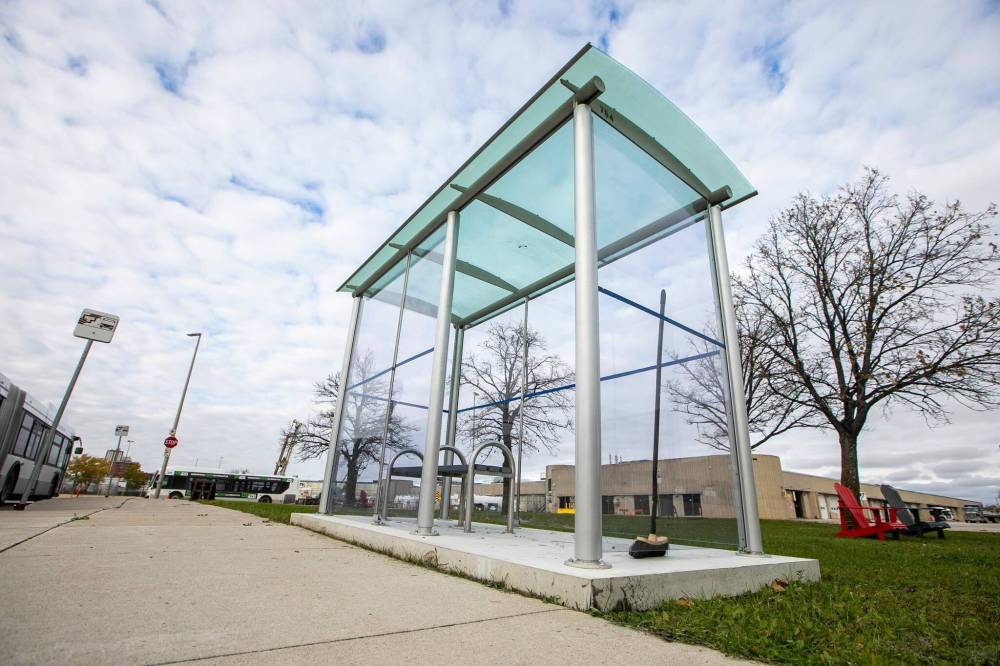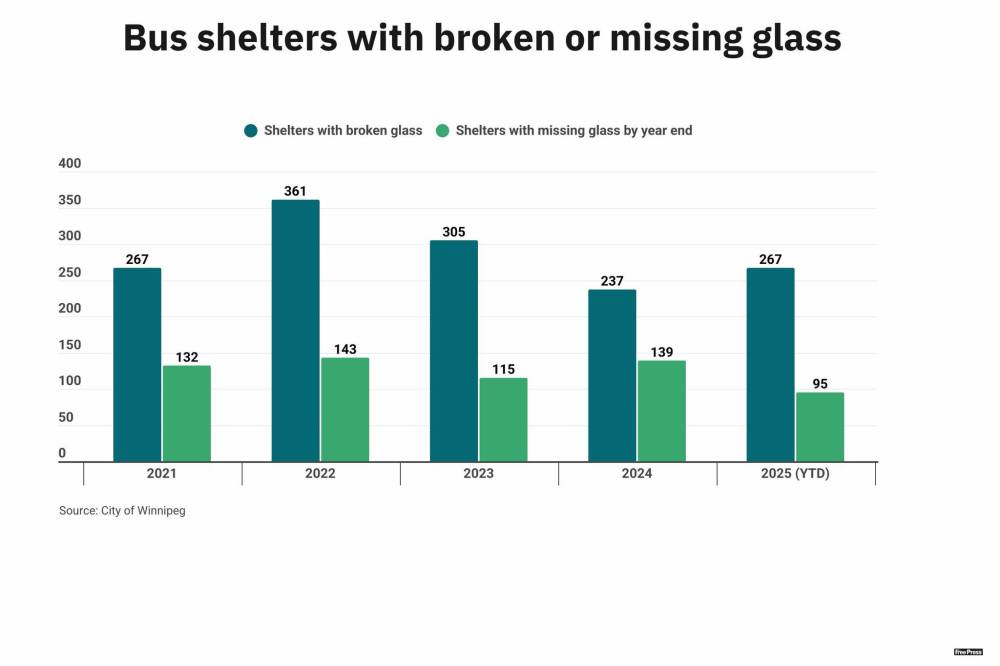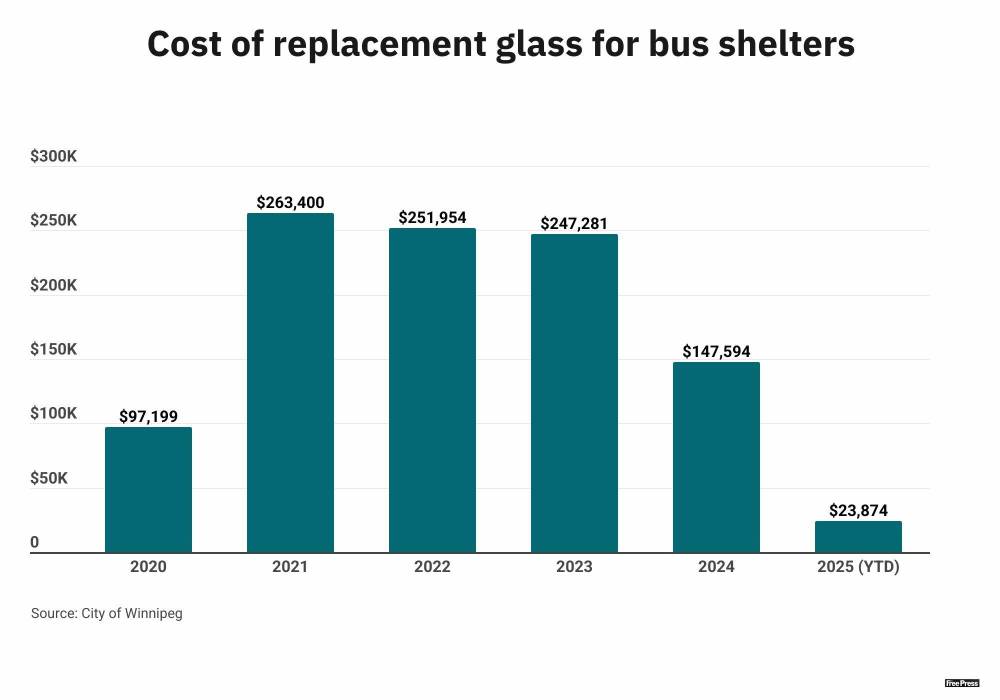Sledgehammer-proof panels installed at bus shelters
Pilot project begins after city spent nearly $150K on glass replacement in 2024
Advertisement
Read this article for free:
or
Already have an account? Log in here »
To continue reading, please subscribe:
Monthly Digital Subscription
$1 per week for 24 weeks*
- Enjoy unlimited reading on winnipegfreepress.com
- Read the E-Edition, our digital replica newspaper
- Access News Break, our award-winning app
- Play interactive puzzles
*Billed as $4.00 plus GST every four weeks. After 24 weeks, price increases to the regular rate of $19.00 plus GST every four weeks. Offer available to new and qualified returning subscribers only. Cancel any time.
Monthly Digital Subscription
$4.75/week*
- Enjoy unlimited reading on winnipegfreepress.com
- Read the E-Edition, our digital replica newspaper
- Access News Break, our award-winning app
- Play interactive puzzles
*Billed as $19 plus GST every four weeks. Cancel any time.
To continue reading, please subscribe:
Add Free Press access to your Brandon Sun subscription for only an additional
$1 for the first 4 weeks*
*Your next subscription payment will increase by $1.00 and you will be charged $16.99 plus GST for four weeks. After four weeks, your payment will increase to $23.99 plus GST every four weeks.
Read unlimited articles for free today:
or
Already have an account? Log in here »
‘Virtually unbreakable’ glass panels are being installed at some bus shelters as part of a pilot project aimed at reducing vandalism in Winnipeg.
Work to install polycarbonate panels at 30 “high-use” shelters across the city is underway at a cost of $150,000. The material is 250 times more impact-resistant than safety glass and is used by several other Canadian transit systems, the city stated.
Coun. Janice Lukes said the city was tired of constantly replacing shattered glass panels at bus shelters and though the polycarbonate version is 15 per cent more expensive to install than glass, it will save money in the long run.
“The cost was getting exorbitant and this new stuff is virtually unbreakable,” she said.
MIKAELA MACKENZIE / FREE PRESS Work to install polycarbonate panels at 30 “high-use” shelters across the city is underway at a cost of $150,000.
Lukes, who is chairwoman of the public works committee, recently took a tour of a polycarbonate manufacturing plant in Winnipeg and pounded a pane with a sledgehammer. The material held up, she said.
Winnipeg Transit crews have refitted three shelters with the material and repaired glass panels at 70 locations in recent weeks, the city said.
Transit communications officer Brandon Logan would not disclose the locations of the pilot shelters. In an email, he said the city wants to see how the panels hold up to daily wear-and-tear and does not want to make the shelters a target. The city will monitor the shelters over the next year to gauge their efficacy. If successful, the pilot could expand.
Vandalism at bus shelters has grown in recent years, city data show.
Statistics show 267 bus shelters were impacted by broken glass in 2021, followed by 361 in 2022, 305 in 2023 and 237 in 2024.
The city spent $147,593.90 on replacement glass for bus shelters in 2024 alone.
The city has 880 bus shelters, including 170 that are heated.
The plan to test shatter-proof glass at shelters has long been in the works. Winnipeg Transit said it planned to test the polycarbonate panels at shelters in November 2023 but did not post a tender to buy the material until a year later.
Coun. Evan Duncan (Charleswood-Westwood-Tuxedo) reported 11 shelters along Grant Avenue with smashed glass throughout the summer. At the Dale and Roblin Boulevard bus stop, there have been complaints of an encampment forming inside the shelter.
“That’s not going to happen,” he said. “It’s just not something that I’m supporting and that I’m actually pushing to make sure that it’s almost instantaneous when somebody is reported to be staying in a shelter that they’re moved out.”
Lukes (Waverely West) couldn’t say why the shelters were being smashed, but speculated addiction and mental-health issues might play a part.
“I don’t know if it’s because people are frustrated and they didn’t want people living in shelters, so they went out and did a little bit of smashing on their own,” she said. “Unless it’s on camera we don’t really know.”
Bus shelters in Winnipeg are not monitored by security cameras.
Lukes says she’s not concerned the retrofitted bus shelters will become encampments, noting the city’s incoming bylaw prohibits them in such locations. She hopes the province’s Your Way Home homelessness strategy will also aid in getting people out of bus shelters and into housing. The city’s new transit system also requires functional shelters.
“Our new system is based on bus transfers because of the spine-and-feeder system … we have to be using these shelters for transit, not for home,” she said.
Approximately 150 shelters were removed from stops across Winnipeg as part of the transit network’s launch, Logan said.
— with files from Scott Billeck
nicole.buffie@freepress.mb.ca

Nicole Buffie
Multimedia producer
Nicole Buffie is a reporter for the Free Press city desk. Born and bred in Winnipeg, Nicole graduated from Red River College’s Creative Communications program in 2020 and worked as a reporter throughout Manitoba before joining the Free Press newsroom as a multimedia producer in 2023. Read more about Nicole.
Every piece of reporting Nicole produces is reviewed by an editing team before it is posted online or published in print — part of the Free Press‘s tradition, since 1872, of producing reliable independent journalism. Read more about Free Press’s history and mandate, and learn how our newsroom operates.
Our newsroom depends on a growing audience of readers to power our journalism. If you are not a paid reader, please consider becoming a subscriber.
Our newsroom depends on its audience of readers to power our journalism. Thank you for your support.




